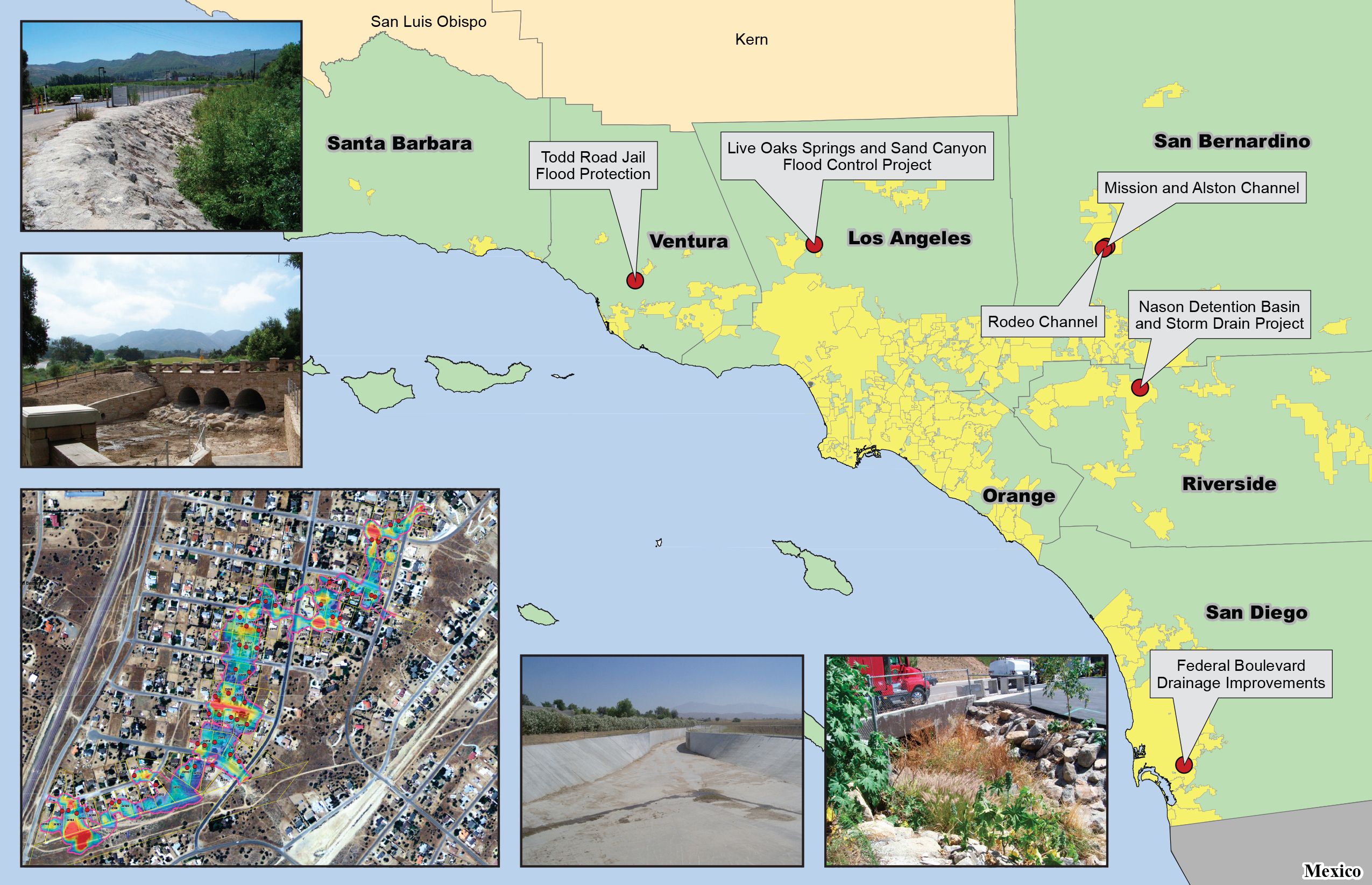Study Summary
Study Area – Southern California counties designated in 1577-DR-CA or 1585-DR-CA (Los Angeles, Orange, Riverside, San Bernardino, San Diego, Santa Barbara, and Ventura Counties)
Hazard Type – Flood
Project Type – This study evaluated six structural flood control mitigation projects in southern California counties following several flooding events in late 2004 and early 2005:
- Live Oaks Springs and Sand Canyon Project in Santa Clarita, Los Angeles County, detention basin and channel rerouting.
- Mission and Alston Channel Project in Hesperia, San Bernardino County, detention basin, channel improvements (with storm drain pipe), and improved outlet.
- Rodeo Channel in Hesperia, San Bernardino County, channel improvements and new storm drain outlet pipe.
- Nason Detention Basin in Moreno Valley, Riverside County, detention basin and new storm drain pipe.
- Federal Boulevard Drainage Improvements in Lemon Grove, San Diego County, new storm drain pipes and street curb inlets.
- Flood Protection for Todd Road Jail Facility in Santa Paula, Ventura County, channel armoring.
Total Aggregate Project Cost – $19,575,932 (six projects)
Total Aggregate Losses Avoided – $7,309,402 (2007 dollars)
Return on Investment (ROI) – 0.37
Pre- and Post-Mitigation Events
FEMA Region IX and the California Office of Emergency Services (OES) initiated the Southern California Loss Avoidance study following flooding that occurred during December 2004, January 2005, and March 2005, leading to Presidential Disaster Declarations 1577-DR-CA and 1585-DR-CA. Officials noted that the flood losses from the 2004 and 2005 events were less than those from the 1995 California winter storms as a result of flood control mitigation projects implemented in the early 1990s.
Loss Avoidance Methodology
The purpose of this Loss Avoidance Study (LAS) is to verify potential effectiveness and document economic performance of structural flood control mitigation projects in southern California. Initially, 37 projects in southern California counties were selected for inclusion in this study. Most projects were eliminated from the LAS based on a lack of data. Only six projects had enough data to be included in the final LAS. Figure 1 shows the locations of the six projects included in this study.

To analyze the effectiveness of the flood control mitigation projects, FEMA and OES completed a storm event analysis and a flow parameter analysis. For the storm event analysis, only one project had stream gage data available for the reach of interest. For all other projects, the runoff was estimated from rainfall data. Hydraulic modeling was needed to determine the pre- and post-mitigation conditions. Where such modeling was not available from the project files, new models were created for the projects that had detailed topography data. The inundation from the hydraulic analysis was mapped and compared to aerial imagery to determine whether project locations would be affected by flooding post-mitigation. Damages were estimated considering physical damage costs, loss of function costs, and emergency management costs.
Return on Investment
The total aggregate losses avoided for the projects analyzed in the Southern California LAS were $7,309,402. The total project costs were $19,575,932. This results in an average ROI of 0.37. Five of the six projects were completely effective, resulting in no damages in the post-mitigation flood event. One individual project (Federal Boulevard Drainage Improvements) had a ROI ratio greater than 1.0, this means that the project has already paid for itself in losses avoided after only one flooding event. All projects were completed in the last 5 to 10 years and experienced only one flooding event since construction. If similar events occur in the next 10 to 20 years, the project investment will be fully recovered well within the intended lifespan of the projects.

